Sony WF-1000XM4 vs. Sony WF-1000XM3: Which Sony noise-cancelling earbuds should you buy?
Our Sony WF-1000XM4 and Sony WF-1000XM3 comparison will determine the better Sony wireless ANC earbuds
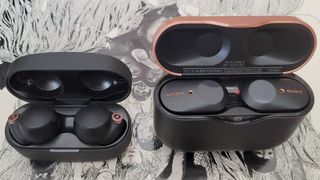
This Sony WF-1000XM4 vs. Sony WF-1000XM3 face-off compares two of the category’s best noise-cancelling earbuds, helping you decide which pair best suits your needs and budget.
Recently launched, the Sony WF-1000XM4 is a fantastic upgrade that ups the ante on audio, battery life, and most importantly, active noise cancellation. A complete redesign introduces new ergonomics for a more secure fit, while extended functionality via the Sony Headphones Connect app sweetens the deal.
- Check out more of the best Apple AirPods alternatives
- The best noise cancelling headphones: Our top picks
- Sony WF-1000XM4 vs. Bose QuietComfort Earbuds: Which wireless earbuds win?
A trendsetter in the category when originally released, the Sony WF-1000XM3 helped set the bar for both ANC and battery life in the true wireless space. Sound remains some of the finest that you’ll hear, plus you’re given access to most of the same audio features present in the latest model. Compatibility to Sony’s companion app will provide you multiple ways to personalize the buds, from ambient listening to upscaled audio resolution.
We’ve taken both the WF-1000XM4 and WF-1000XM3 on test runs, comparing every major characteristic to determine which pair of Sony wireless ANC earbuds you should actually buy.
Sony WF-1000XM4 vs. Sony WF-1000XM3: Specs compared
| Header Cell - Column 0 | Sony WF-1000XM4 | Sony WF-1000XM3 |
|---|---|---|
| Price | $279 | $175 (originally $229) |
| Wireless charging | Yes | No |
| Chip | Sony V1 | Sony QN1e |
| Rated battery life | 8 hours (ANC on), 12 hours (ANC off), 24 hours (with charging case), 36 hours (with charging case and ANC off) | 6 hours (ANC on), 8 hours (ANC off), 18 hours (with charging case) |
| Water-Resistant | IPX4 | No |
| Case Size | 2.4 x 1.5 x 1.1 inches | 3.2 x 2.2 x 1.3 inches |
| Case Weight | 2 ounces | 2.8 ounces |
| Special Features | Active noise cancellation, transparency mode, Speak-to-Chat, customizable EQ, 360 Reality Audio, DSEE Extreme upscaling, LDAC, Bluetooth 5.2, tri-digital assistant support (Alexa, Google Assistant, and Siri), quick charging | Active noise cancellation, transparency mode, customizable EQ, 360 Reality Audio, DSEE HX upscaling, NFC, tri-digital assistant support (Alexa, Google Assistant and Siri) |
Sony WF-1000XM4 vs. Sony WF-1000XM3: Price
The Sony WF-1000XM4 is listed at $279. That's $50 higher than what its predecessor originally launched at, and the WF-1000XM3 has only been dropping since. It doesn’t come cheap, but, then again, Sony sound and noise cancellation never did. Well, at least when it comes to the Mark series.
Two years on the market and the Sony WF-1000XM3 has received numerous markdowns, making it the more attainable and enticing value option. Major online retailers like Amazon and Best Buy have had it for as low as $148.
For all of the latest Sony headphones deals, be sure to bookmark our best headphones deals pages.
Winner: Sony WF-1000XM3
Sony WF-1000XM4 vs. Sony WF-1000XM3: Design

Sony knew it had to completely overhaul the design of its next-gen wireless earbuds. Not only is the WF-1000XM4 quite an attractive model that borrows elements from the original, like the copper accents, but it also makes numerous welcome improvements. These include larger touch panels, copper ANC mic housings and an oval shape to more easily nestle in the ear. These buds come IPX4 rated for sweat and water resistance as well.
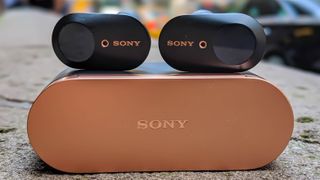
We found the WH-1000XM3’s flat and elongated form to be distinctively handsome when it was first shown, but the design has not aged well. It’s just too big and sticks out like a sore thumb. No IP-rated protection doesn’t help the older buds’ cause, either.
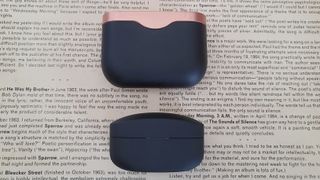
For the WF-1000XM4 case, Sony took the WF-SP800N case and implemented small changes (like a larger LED, gold logo) while also scaling down the size a few inches to make it convenient for travel.
The WF-1000XM3 case is more visually striking, though. Holding it on the side gives it a sleek cigarette holder appearance, which is something that will resonate with the wannabe Don Drapers of the world. The two-tone black-and-copper finish gives it some pop, too.
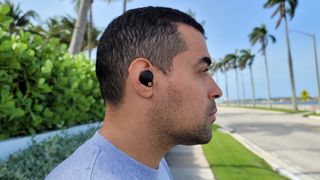
One of the main reasons Sony switched up the WF-1000XM4’s design was to ensure a more secure fit, but the buds struggle to achieve this. The installed tips don’t create a tight seal around the canal for proper stabilization, causing the buds to slip out on occasion. We preferred using the bundled silicone tips and took advantage of Sony’s Optimal Earbud Tips to gain the best feedback for optimal fit. Once getting the buds on your ears, then you have to worry about the long sound port pinching the concha; expect discomfort after about an hour of wear.
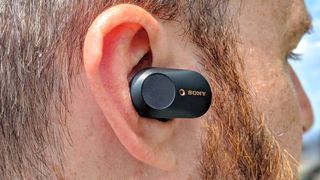
The Sony WF-1000XM3 provides acceptable comfort with the angled sound port easily sliding into the canal and not too deeply, unlike the WF-1000XM4. Sadly, fit is no better, with weight distribution being off and the buds slipping out whenever walking fast. Also, the long-shaped design occupies to much ear real estate and feels awkward at times.
Winner: Sony WF-1000XM4
Sony WF-1000XM4 vs. Sony WF-1000XM3: Controls and digital assistant

The touch controls on the over-ear Sony WH-1000XM3 impressed the hell out of us, but that same performance didn’t translate well to the in-ear variant: the WF-1000XM3. Tap gestures aren’t responsive and often require two to three attempts before intended commands are executed. We discovered that employing slide gestures works better for playback and call management. On-ear detection also works half the time to automatically pause music when removing the buds.
The WF-1000XM4 is a vast improvement, with larger, more reliable touch panels and new voice features for hands-free operation. A full set of media controls are available, including on-board volume controls, and the sensors do a better job of detecting when your buds are coming off or being placed back into your ears for automatic playback. You can even lower the volume to about 10% by enabling the Quick Attention mode (long press on the left bud) or use the speak-to-chat feature to pause music whenever speaking.
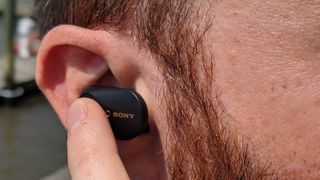
The mics arrays on both models are powerful and pick up every syllable that comes out of your mouth. This makes for great digital assistant support. The only difference is that the WF-1000XM4 comes with Google Assistant and Alexa integration, meaning you can activate either AI bot by saying their respective action phrases: “Hey Google” or “Alexa.” You don’t get this on the WF-1000XM3. For all of you iOS users, yes, Siri works on either set of buds.
Winner: Sony WF-1000XM4
Sony WF-1000XM4 vs. Sony WF-1000XM3: Active noise cancellation

Sony’s new V1 chip is what gives the WF-1000XM4 is noise-neutralizing horsepower. The processor achieves 40% lower noise levels and enhances ANC of high frequencies compared to the QN1e chip, which is what the WF-1000XM3 uses. We noticed the difference when walking through high-traffic areas. The technology put a kibosh on rowdy pedestrians, truck engine rumbling, and street construction that took place about a block away.
The WF-1000XM3 subdues background noise very well. These buds are useful for quieting keyboard clatter and chatty co-workers, as well as street-level sounds like truck horns and whisking cars. Louder noises like baby cries and police sirens are unavoidable, but often blend into the soundscape and come off like background effects on songs; the same applies to the WH-1000XM4.

Ambient Sound Control grants you 20 levels of transparency that you can adjust on either set of buds. The WH-1000XM4’s mics are stronger and pick up more external sounds, but your environmental awareness will still be high to identify noises on the WF-1000XM3. Two other ambient features shared on these models are the ability to focus on voice and automatic switching, which detects your actions and frequented locations to adjust ambient listening.
Wind resistance is the determinant is this category. Our experience with using the WF-1000XM3 in gusty conditions wasn’t pleasant. That isn’t to say the WF-1000XM4 was perfect because it wasn’t, not by a long shot. It does come with an Automatic Wind Noise Reduction feature to decrease wind presence.
Winner: Sony WF-1000XM4
Sony WF-1000XM4 vs. Sony WF-1000XM3: Sound quality

Sony deserves credit for refining what is already a stellar sound profile and bestowing it upon the WF-1000XM4. Everything from music to movies sound excellent with the buds pumping out clean, detailed, and vibrant audio. Vocals are given prominence and instrument separation is exceptional to hear every musical tool played on orchestral tracks. You will pick up on subtle nuances in complex recordings as well.
We’re not mad that Sony toned down the bass levels, as it gives these buds a full-bodied soundstage that blends lows, mids and highs incredibly well. Sony’s 360 Reality Audio platform gives music a more immersive feel that you can enjoy on compatible streaming services like Deezer and Tidal, while DSEE Extreme technology boosts the fidelity on standard-definition tracks.
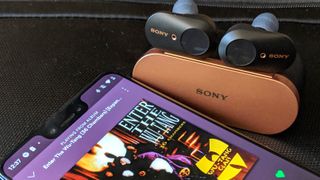
Sony fanboys will likely favor the WF-1000XM3 for its ultra-bass delivery and there is nothing wrong with that. These buds pack a mean punch that hits hard when blasting contemporary tracks and does so without diminishing sound quality, even when listening in ANC mode. Reproduction is on point to hear distinct imperfections on mono recordings. It’s also great that Sony extends its 360 Reality Audio and DSEE Extreme technologies to this older model, along with AAC and SBC codec support.
Winner: Sony WF-1000XM4
Sony WF-1000XM4 vs. Sony WF-1000XM3: App and special features
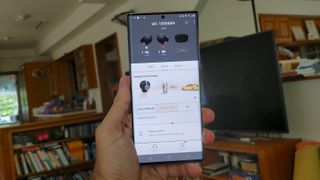
The Sony Headphones Connect app is the hub for all extended functionality and both of these models support most of the main features. These include the aforementioned 360 Reality Audio, ANC, ambient listening, control customization, and DSEE Extreme. Other features like Speak-to-Chat, voice activation, and the Optimal Earbud Tips test are reserved for the WF-1000XM4, along with Bluetooth Connection Quality to prioritize sound quality or connectivity.

Many will agree that the Equalizer is the app’s most notable feature. On top of being able to adjust frequency levels and create your own sound profiles, there are eight solid presets that pair perfectly with their music genre or targeted content. Battery level indicators for both earbuds and the charging case, toggle controls for multiple functions, a music player, and firmware updates complete the package.
There are differences in connectivity between these two products. Where the WH-1000XM4 operates on the newer Bluetooth 5.2 and comes with one-touch pairing for Android devices via Google Fast Pair, the WH-1000XM3 runs on Bluetooth 5.0 and supports NFC to instantly pair the buds when tapping the charging case on a compatible smartphone. The good news is you’ll enjoy stable connections and a lengthy range (35 feet, roughly), no matter the model.
Winner: Sony WF-1000XM4
Sony WF-1000XM4 vs. Sony WF-1000XM3: Call quality

Neither of these serve well as calling headsets, but if you want to know which is serviceable when in a pinch, that would be the WF-1000XM4. The stronger mic array produces better clarity for video chats, though you’ll need to be in a quiet room to ensure the best quality. We had a few callers complain about background noise on our end, as well as lots of muffling, especially outside.
Even with the latest software updates, the WF-1000XM3 is frustrating for calls. Muffling remains a huge issue and sometimes speech will cut out entirely. Wind resistance is poor with the buds producing an uncomfortable whooshing effect that’s harmful to your hearing.
Winner: Sony WF-1000XM4
Sony WF-1000XM4 vs. Sony WF-1000XM3: Battery life
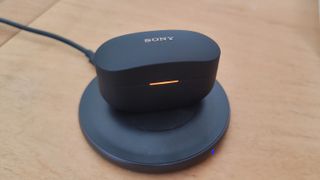
The WF-1000XM3 set the standard for battery life for wireless ANC earbuds when it launched: 6 hours. That was a significant amount at the time, especially since the AirPods Pro (4.5 hours) offers so little. Unfortunately, other models have caught up and come with longer ANC playtimes, including the WF-1000XM4, which gives you between 7 to 8 hours. Disabling the feature extends playtimes on each model, but the WF-1000XM4 provides 4 hours more.

Where the WF-1000XM4 charging case holds between 24 to 36 hours, the WF-1000XM3 charging case is capped at 18 hours. Quick charging is also stronger on the WF-1000XM4, generating 1 hour of use on a 5-minute charge. The Sony WF-1000XM3 isn’t that far off with a 10-minute charge netting you 90 minutes of listening time.
Wireless charging is only available on the WF-1000XM4.
Winner: Sony WF-1000XM4
Sony WF-1000XM4 vs. Sony WF-1000XM3: Verdict
The Sony WF-1000XM4 improves on its elder counterpart in so many ways. A stronger spec sheet highlighted by Sony’s new V1 chip results in better ANC and sound quality, along with faster and stronger connectivity. Battery life gets a generous boost as well.
We’re also surprised at how accurate and responsive the smart controls are on these buds. Sony’s decision to scale back bass for more full-bodied sound won’t sit right with everyone, but at least you’re given the opportunity to fix it in the companion app. We just wish Sony placed more focus on fit, call quality, and some notable omissions, namely, multipoint and NFC.
| Header Cell - Column 0 | Sony WF-1000XM4 | Sony WF-1000XM3 |
|---|---|---|
| Value (5) | 4 | 5 |
| Design (15) | 11 | 9 |
| Controls (10) | 8 | 6 |
| Noise Cancellation (20) | 18 | 17 |
| Audio (20) | 19 | 18 |
| Special Features and Apps (15) | 13 | 11 |
| Call Quality (5) | 3 | 2 |
| Battery Life (10) | 9 | 8 |
| Total Score (100) | 84 | 76 |
It’s tough to compete with a superior of version of yourself, especially when the new and improved model boasts more enhancements and newer hardware. The WF-1000XM3 doesn’t come out on top, but it is still one some of the finest-sounding wireless earbuds you’re going to find at any price point.
The bass-heavy soundstage will satisfy music lovers that want head-rattling performance in a tinier package. ANC still ranks highly, so does battery life. This model does share many of the same complaints as its sibling, but it’s the impractical design and poor controls that seal its fate in this battle.
- On a tight budget? Here are the best cheap noise-cancelling headphones
Sign up to get the BEST of Tom's Guide direct to your inbox.
Get instant access to breaking news, the hottest reviews, great deals and helpful tips.
A lifestyle journalist with an affinity for consumer products, Alex has over a decade of experience and has worked with popular publications such as Complex, Thrillist, Men’s Health, Gear Patrol, AskMen, and Hoop Magazine. He currently focuses on audio, reviewing the most coveted headphones in the market for both Tom’s Guide and Laptop Magazine.
